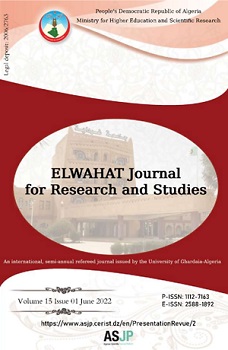Social learning (imitation, Modeling) during early childhood
Résumé
Abstract:
The aim of this research paper is to follow the process of social learning in the newborn, via two concepts (imitation, modeling). Controversial results indicate that the newborn may imitate adult gestures. Imitative activities of infants between one and six months are not well known. Imitative behavior then becomes more frequent and more refined.
This development is achieved through reinforcement and reciprocal play between the adult and the infant, while interactions with peers, or with strangers. Imitation and modeling are models of social learning that are characterized by observation in the first instance. Observation of behavior of the other participates in the socialization of the human person and in his acculturation. However, its functional aspects are poorly known in early childhood.
Keywords: Social learning; Imitation; Modeling; Early childhood
Références
- Abramovitch, R., & Grusec, J. E. (1978). Peer imitation in a natural setting. Child Development, 49(1), 60–65. https://doi.org/10.2307/1128593
- Bandura, A. (1977). Social learning theory. Englewood Cliffs, NJ: Prentice Hall.
-Bandura, A.(1985). L'apprentissage social. Bruxelles : Mardaga
-Bijou, S. W., & Baer, D. M.( 1978). Child development: A behavior analysis approach. Englewood Cliffs, N. J.: Prentice-Hall.
-Bower, T.G.R.(1979) . Human Development. San Francisco: W. H. Freeman and Company.
-Carroll, W. R. et Bandura, A. (2007). The role of visual monitoring in observational learning of action patterns: Making the un-observable observable. Quest, 14 (40), 502-551.
-Connolly, K.J., & Prechtl, H.F. (1981). Maturation and development. London: Spastic International Publications.
- Fenouillet .F.(2003).La motivation. Paris :Dunod
-Field ,T.(1977) .effect of early separation , interaction deficit and experimental manipulation on infant –mother face –to face .child devlopment.48.763-771.
- Gladstone, B. W., & Cooley, J. (1975). Behavioral similarity as a reinforcer for preschool children. Journal of the Experimental Analysis of Behavior, 23(3), 357–368. https://doi.org/10.1901/jeab.1975.23-357
- Gewirtz, J.L. (1972). Deficiency conditions of stimulation and the reversal of their effects via enrichment. In F.J. Monks, W.W. Hartup, & J. De Wit (Eds.), Determinants of Behavioral Development (pp. 349-375). New York and London: Academic Press.
- Grusec, J. E., & Abramovitch, R. (1982). Imitation of peers and adults in a natural setting: A functional analysis. Child Development, 53(3), 636–642. https://doi.org/10.2307/1129374
- Hayes L., Watson J.(1981).Neonatal imitation: fact or artifact? Dev. Psychol. 177, 660–665
- Killen, M. and I.C. Uzgiris , 1978. Imitation of actions with objects . Paper presented at the International Conference on Infant Studies, Providence, RI, March 1978. https://doi.org/10.1080/00221325.1981.10534136
- Kaye, K., & Marcus, J. (1981). Infant Imitation: The Sensory-Motor Agenda. Developmental Psychology, 17, 258-265.
http://dx.doi.org/10.1037/0012-1649.17.3.258
- Lewis, M. Feiring ,C.(1981). Direct and indirect interactions in social relationships .In L.P.Lipsitt (E.d ) . Advances in Infancy Research, Vol. 1. New York: Ablex Publishing, p129-161
-Lubin,L ., Field ,T.M.(1981) .Imitation during preschool peer interaction .International journal of behavioural development .volume 4.4. 443-453 DOI :10.1177/016502548100400404
-McCall ,R. B. (1977). Imitation of Live and Televised Models by Children One to Three Years of Age. Monographs of the Society for Research in Child Development Vol. 42, No. 5. pp. 1-94: Wiley .https://doi.org/10.2307/1165913
-Meltzoff, A. N. & Moore, M. K. (1977). Imitation of facial and manual gestures by human neonates. Science. Vol 198, Issue 4312 . pp. 75-78 • DOI: 10.1126/science.198.4312.75
-Mounoud, P. (1979). Développement cognitif: Construction de structures nouvelles ou construction d'organisations internes. Bulletin de Psychologie,33. 343, 107-118 https://archive-ouverte.unige.ch/unige:22674
-Parton, D. A.(1976). Learning to imitate in infancy, Child Development, 47, 14-31.
- Piaget, J.(1945) . La formation du symbole chez l’enfant . Imitation, jeu et rêve. Image et représentation. Neuchâtel ; Delachaux et Niestlé
- Sherman, J. A., Clark ,H. B, Kelly K.K.(1977). Imitative Behavior of Preschool Children: The Effects of Reinforcement, Instructions, and Response Similarity, in Barbara C. Etzel, Judith M. LeBlanc, Donald M. Baer .New Developments in Behavioral Research: Theory, Method and Application.1st edition.UK: Routledge. DOI: 10.4324/9781003046110
-Skinner.B.F.(1978). Reflections on behaviorism and society. Englewood Cliffs, N.J. : Prentice-Hall
-Rodgon, M. M., & Kurdek, L. A. (1977). Vocal and gestural imitation in 8-, 14-, and 20-month-old children. The Journal of Genetic Psychology: Research and Theory on Human Development, 131(1), 115–123. https://doi.org/10.1080/00221325.1977.10533280
- Thelen,M. H; Dollinger,S J. Kirkland ,K. D.(1979). Imitation and Response Uncertainty. The Journal of Genetic Psychology .volume 135.1.139-152
https://doi.org/10.1080/00221325.1979.10533425
-Thelen, E., & Fisher, D. M. (1982). Newborn stepping: An explanation for a "disappearing" reflex. Developmental Psychology, 18(5), 760–775. https://doi.org/10.1037/0012-1649.18.5.760
-Wikipedia.(2019). Imitation (processus d'apprentissage).retrieved 07/2019 from https://fr.wikipedia.org/wiki/Imitation_(processus_d%27apprentissage)






